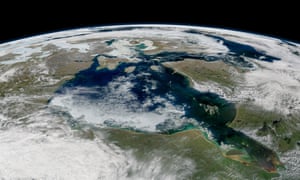Extract from The Guardian
The $1bn, decade-in-the-making creation can measure height and thickness of ice sheets to within a centimeter
The world will soon have a much clearer picture of how quickly humans
are melting Earth’s ice and expanding the seas, with data collected by a
sophisticated satellite launched by Nasa.
Every 91 days, the $1bn, decade-in-the-making creation will orbit over more than 1,000 paths. The satellite, about the size of a Smart car, will point six lasers at ice sheets in the Arctic and Antarctica. It will then calculate how long the beams take to bounce back. Nasa will be able to more accurately measure the heights of ice sheets and the thickness of remaining sea ice.
“With sea ice, we’ve been able to measure the extent (or area) really well since about 1980 … but what we haven’t been able to measure is the thickness,” said Tom Neumann, Nasa’s deputy project scientist for the mission. “Thickness is a key piece of the puzzle because thinner sea ice is broken up more easily by storms. It melts faster. So it gives you some insight into why the area is changing the way it is.”
Melting ice in Greenland and Antarctica has increased the global sea level more than a millimeter per year, a third of the overall increase, according to Nasa. Sea-level rise is getting faster, and seas could be several feet higher by the end of the century.
The IceSat-2, launched Saturday, replaces an original satellite that has been out of commission since 2009. Between 2003 and 2009, the measured sea ice lost 40% of its thickness, Neumann said.
Since then, Nasa has used a plane to take more rudimentary measurements of ice melt for about a month per year in the Arctic and Antarctic. That covered less ground but allowed Nasa to monitor the fastest changing parts of the ice sheets and sea ice.
Neumann said it’s possible the satellite will find ice loss beyond what Nasa has measured so far. Gaps in data, including in east Antarctica, could show ice shrinking or growing.
The new satellite will provide more complete coverage and measure to within a centimeter.
“In the time it takes someone to blink, sort of half a second, IceSat-2 is going to collect 5,000 measurements in each of its six beams, and it’s going to do that every hour, every day … it’s a tremendous amount of data,” Neumann said.

Every 91 days, the $1bn, decade-in-the-making creation will orbit over more than 1,000 paths. The satellite, about the size of a Smart car, will point six lasers at ice sheets in the Arctic and Antarctica. It will then calculate how long the beams take to bounce back. Nasa will be able to more accurately measure the heights of ice sheets and the thickness of remaining sea ice.
“With sea ice, we’ve been able to measure the extent (or area) really well since about 1980 … but what we haven’t been able to measure is the thickness,” said Tom Neumann, Nasa’s deputy project scientist for the mission. “Thickness is a key piece of the puzzle because thinner sea ice is broken up more easily by storms. It melts faster. So it gives you some insight into why the area is changing the way it is.”
Melting ice in Greenland and Antarctica has increased the global sea level more than a millimeter per year, a third of the overall increase, according to Nasa. Sea-level rise is getting faster, and seas could be several feet higher by the end of the century.
The IceSat-2, launched Saturday, replaces an original satellite that has been out of commission since 2009. Between 2003 and 2009, the measured sea ice lost 40% of its thickness, Neumann said.
Since then, Nasa has used a plane to take more rudimentary measurements of ice melt for about a month per year in the Arctic and Antarctic. That covered less ground but allowed Nasa to monitor the fastest changing parts of the ice sheets and sea ice.
Neumann said it’s possible the satellite will find ice loss beyond what Nasa has measured so far. Gaps in data, including in east Antarctica, could show ice shrinking or growing.
The new satellite will provide more complete coverage and measure to within a centimeter.
“In the time it takes someone to blink, sort of half a second, IceSat-2 is going to collect 5,000 measurements in each of its six beams, and it’s going to do that every hour, every day … it’s a tremendous amount of data,” Neumann said.

The US Geological Survey is interested in the elevation data, and the navy would like to look at how changes will affect shipping channels, he said. With ice melt, new routes are expected to open through the Arctic, significantly reducing shipping times.
Nasa has an entire fleet of satellites observing Earth, including for signs of climate change. Trump this year proposed cutting the budget that funds many of the others.
Private companies and public interest groups and even the state of California have announced their own plans for climate-related satellites.
A collaboration between the Environmental Defense Fund and Harvard University is expected to launch in 2021 and as will pinpoint methane leaks from oil and gas operations.
Steven Hamburg, chief scientist for EDF, said researchers realized they could build the satellite faster and cheaper than the government. EDF research suggests oil and gas companies in the US leak 60% more methane than environmental regulators estimate.
Methane traps far more heat than the more common carbon dioxide. Because it is short-lived, cutting emissions would have a rapid impact on temperatures, Hamburg said.
The European Space Agency has a satellite that measures greenhouse gases, but it doesn’t specify in detail where leaks are happening. GHGSat, a private company, expects to launch a second greenhouse-gas-monitoring satellite soon.

No comments:
Post a Comment